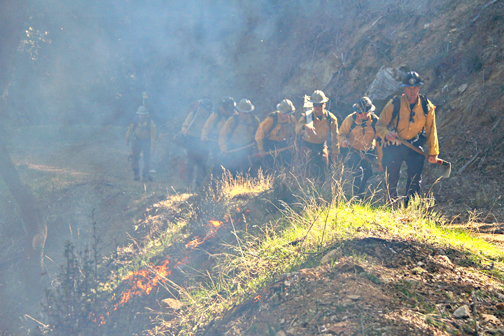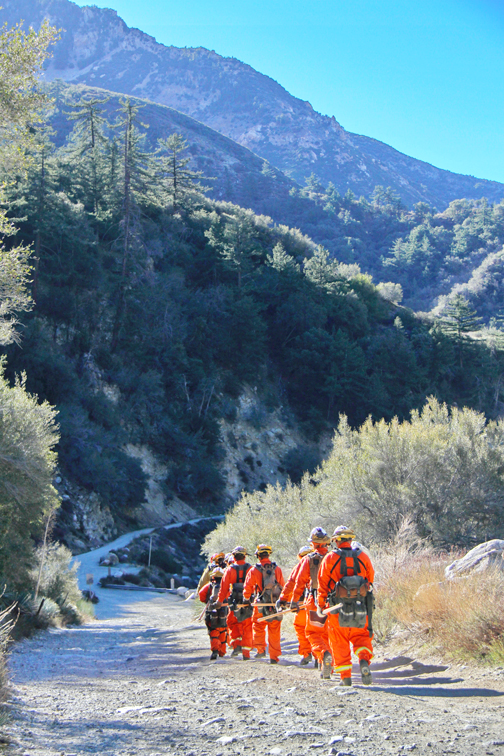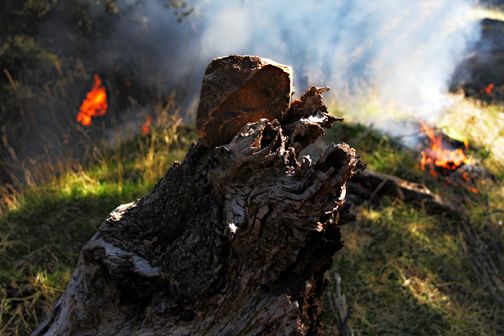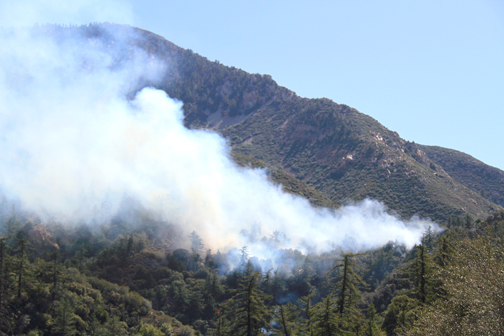
Firefighters trudge through the hillside as smoke from a controlled burn surrounds them.
Don’t be alarmed if you see fire in the foothills – it’s part of a planned burn by the fire department.
By Mary O’KEEFE
Community members along the foothills will be smelling and seeing smoke in the next few weeks as the U.S. Forest Service Wildland Fire Dept. conducts prescribed burns in the Angeles National Forest. On Tuesday, U.S. Forest Fire Service, San Bernardino and Los Angeles Counties fire departments began the schedule of prescribed burns in the Mt. Baldy area.
“A prescribed fire is the application of fire as a tool to minimize the fuel loading in a given area,” said Battalion 24 Burn Boss Seth Mitchell.
The burn is advantageous in many ways: it helps clear vegetation, helps return nutrients to the forest floor, provides training for crews and makes the area safer for firefighters to enter in the event of a natural wildfire.
Mitchell said the burn will take care of the fuels that have dropped to the ground from the trees as well as ground fuels. The U.S. Forest Service had contracted with crews, including urban conservation organizations, to pull the dried ground fuels together in piles before the burns. Those piles littered the mountainside of the designated burn area.
“The prescribed fire that we have attended is planned to go through the week, so [people] will see some open flames and some smoke throughout the week probably even into Saturday,” Mitchell said. “The intent of this project is for community defense and firefighter access and the ability for them to get in there to do their job safely.”
The project was planned in 2014; by 2016 the USFS had implemented some hazardous fuel reduction and now, in 2018, the project has moved into the implementation of the prescribed fire.
This is beneficial to most local residents as well. There are about 20 cabins for leisure use in the Mt. Baldy area that had been permitted decades ago. Most are still in use today, in a sheltered valley down a long, narrow dirt trail.
“When a cabin burns down [the owners] cannot rebuild due to the permitting,” said Nathan Judy, U.S. Forest Fire Service spokesman.
The land is Forest Service land and in the past it had permitted homes being built, but the permitting process is much different now. Some of the cabins had already been taken, either by fire or the 1930s flood.
Conducting a prescribed burn is not something that is taken on lightly. Several agencies, including fire, weather services and Air Quality Management District, work together prior to the burn permitting process. AQMD continues to monitor the smoke as the firefighters monitor the weather and if anything changes the fires are immediately extinguished. According to the California Environmental Protection Agency, the state’s smoke management guidelines are to burn only when alternatives to burning are not feasible.
In addition to reducing dangerous dried fuels, a prescribed burn actually helps the ecosystem by recycling nutrients back to the soil and promotes the growth of trees, wildflowers and other plants.
The burn begins with a discussion on what is to be done that day led by the Burn Boss – in Tuesday’s case, Mitchell. He shared the mapped location of where the burn will be done and what is expected of each team. Prior to the day of the burn, firefighters laid hose on the edges of the burn area. Then on the day of the burn, if all goes as planned and the weather holds, the crews are placed in strategic areas and the fire is started.
Firefighters did have to use one of their contingency plans on Tuesday when they found the hose that had been laid out Monday had frozen overnight. That area had to be put on hold until better conditions for a burn could be met, but the opposite bank of the valley was successfully started.
Crews continued to feed the flames with dry brush, while others kept an ever- watchful eye for any flying embers on the hills near the prescribed area.
“We have contingency plans in case something changes,” Judy said.
The burns near Mt. Baldy will continue and are planned in the Mt. Wilson area as well. The burns are a proactive way of being prepared for future fires as well as keeping the forest healthy, Judy said.








